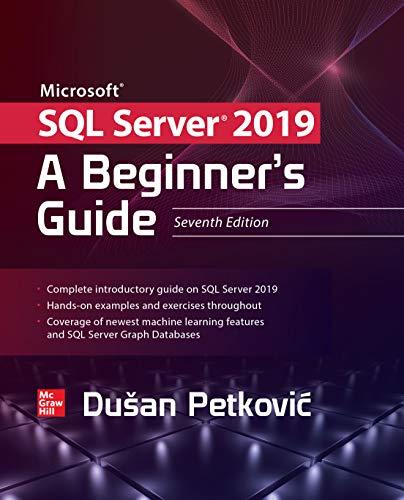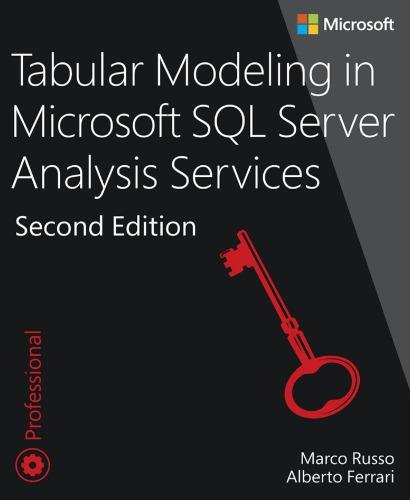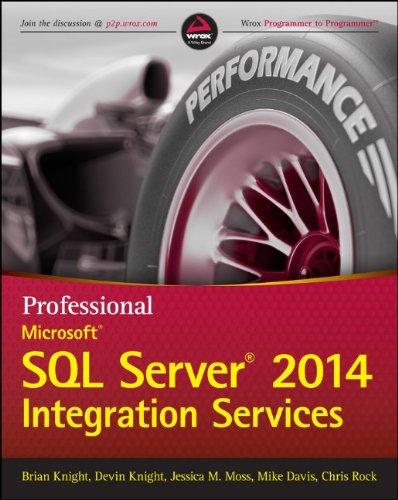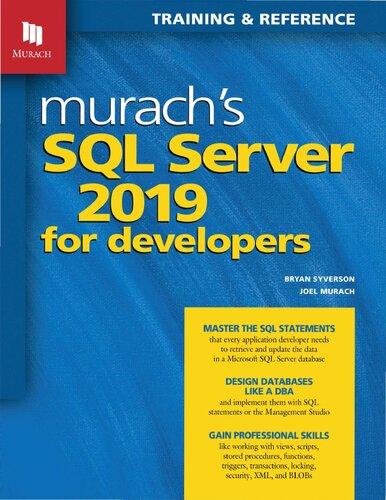Visit to download the full and correct content document: https://textbookfull.com/product/microsoft-sql-server-2019-a-beginners-guide-dusan-p etkovic/

Microsoft SQL Server 2019: A Beginner’s Guide Dusan Petkovic
More products digital (pdf, epub, mobi) instant download maybe you interests ...

Microsoft SQL Server 2016 a beginner's guide Sixth Edition Petkovic
https://textbookfull.com/product/microsoft-sqlserver-2016-a-beginners-guide-sixth-edition-petkovic/

Tabular modeling in Microsoft SQL Server Analysis Service Marco Russo
https://textbookfull.com/product/tabular-modeling-in-microsoftsql-server-analysis-service-marco-russo/

Professional Microsoft SQL Server 2014 Integration Services 1st Edition Brian Knight
https://textbookfull.com/product/professional-microsoft-sqlserver-2014-integration-services-1st-edition-brian-knight/

Azure SQL Revealed: A Guide to the Cloud for SQL Server Professionals Bob Ward
https://textbookfull.com/product/azure-sql-revealed-a-guide-tothe-cloud-for-sql-server-professionals-bob-ward/

Azure SQL Revealed: A Guide to the Cloud for SQL Server Professionals 1st Edition Bob Ward
https://textbookfull.com/product/azure-sql-revealed-a-guide-tothe-cloud-for-sql-server-professionals-1st-edition-bob-ward/

Murach s SQL Server 2019 for Developers 1st Edition
Joel Murach
https://textbookfull.com/product/murach-s-sql-server-2019-fordevelopers-1st-edition-joel-murach/

Query Store for SQL Server 2019 1st Edition Tracy Boggiano Grant Fritchey
https://textbookfull.com/product/query-store-for-sqlserver-2019-1st-edition-tracy-boggiano-grant-fritchey/

Building Custom Tasks for SQL Server Integration Services: The Power of .NET for ETL for SQL Server 2019 and Beyond 2nd Edition Andy Leonard
https://textbookfull.com/product/building-custom-tasks-for-sqlserver-integration-services-the-power-of-net-for-etl-for-sqlserver-2019-and-beyond-2nd-edition-andy-leonard/

Building Custom Tasks for SQL Server Integration Services The Power of NET for ETL for SQL Server 2019 and Beyond Second Edition Andy Leonard
https://textbookfull.com/product/building-custom-tasks-for-sqlserver-integration-services-the-power-of-net-for-etl-for-sqlserver-2019-and-beyond-second-edition-andy-leonard/


Copyright © 2020 by McGraw-Hill Education. All rights reserved. Except as permitted under the United States Copyright Act of 1976, no part of this publication may be reproduced or distributed in any form or by any means, or stored in a database or retrieval system, without the prior written permission of the publisher.
ISBN: 978-1-26-045888-6
MHID: 1-26-045888-1
The material in this eBook also appears in the print version of this title: ISBN: 978-1-26-045887-9, MHID: 1-26-045887-3.
eBook conversion by codeMantra
Version 1.0
All trademarks are trademarks of their respective owners. Rather than put a trademark symbol after every occurrence of a trademarked name, we use names in an editorial fashion only, and to the benefit of the trademark owner, with no intention of infringement of the trademark. Where such designations appear in this book, they have been printed with initial caps.
McGraw-Hill Education eBooks are available at special quantity discounts to use as premiums and sales promotions or for use in corporate training programs. To contact a representative, please visit the Contact Us page at www.mhprofessional.com.
Information has been obtained by McGraw-Hill Education from sources believed to be reliable. However, because of the possibility of human or mechanical error by our sources, McGraw-Hill Education, or others, McGraw-Hill Education does not guarantee the accuracy, adequacy, or completeness of any information and is not responsible for any errors or
omissions or the results obtained from the use of such information.
TERMS OF USE
This is a copyrighted work and McGraw-Hill Education and its licensors reserve all rights in and to the work. Use of this work is subject to these terms. Except as permitted under the Copyright Act of 1976 and the right to store and retrieve one copy of the work, you may not decompile, disassemble, reverse engineer, reproduce, modify, create derivative works based upon, transmit, distribute, disseminate, sell, publish or sublicense the work or any part of it without McGraw-Hill Education’s prior consent. You may use the work for your own noncommercial and personal use; any other use of the work is strictly prohibited. Your right to use the work may be terminated if you fail to comply with these terms.
THE WORK IS PROVIDED “AS IS.” McGRAW-HILL EDUCATION AND ITS LICENSORS MAKE NO GUARANTEES OR WARRANTIES AS TO THE ACCURACY, ADEQUACY OR COMPLETENESS OF OR RESULTS TO BE OBTAINED FROM USING THE WORK, INCLUDING ANY INFORMATION THAT CAN BE ACCESSED THROUGH THE WORK VIA HYPERLINK OR OTHERWISE, AND EXPRESSLY DISCLAIM ANY WARRANTY, EXPRESS OR IMPLIED, INCLUDING BUT NOT LIMITED TO IMPLIED WARRANTIES OF MERCHANTABILITY OR FITNESS FOR A PARTICULAR PURPOSE. McGraw-Hill Education and its licensors do not warrant or guarantee that the functions contained in the work will meet your requirements or that its operation will be uninterrupted or error free. Neither McGraw-Hill Education nor its licensors shall be liable to you or anyone else for any inaccuracy, error or omission, regardless of cause, in the work or for any damages resulting therefrom. McGraw-Hill
Education has no responsibility for the content of any information accessed through the work. Under no circumstances shall McGraw-Hill Education and/or its licensors be liable for any indirect, incidental, special, punitive, consequential or similar damages that result from the use of or inability to use the work, even if any of them has been advised of the possibility of such damages. This limitation of liability shall apply to any claim or cause whatsoever whether such claim or cause arises in contract, tort or otherwise.
About the Author
Dušan Petković is a computer science professor at the Polytechnic in Rosenheim, Germany. He is the bestselling author of the six previous editions of this book and has written numerous articles for SQL Server Magazine.
ABOUT THE TECHNICAL EDITOR
Todd Meister has been working in the IT industry for over 20 years. He’s been a technical editor on over 75 titles ranging from SQL Server to the .NET Framework. Besides technical editing books, he is the Assistant Vice President/Chief Enterprise Architect at Ball State University in Muncie, Indiana. He lives in central Indiana with his wife, Kimberly, and their five phenomenal children.
Acknowledgments
I would like to acknowledge the important contributions of my editor, Lisa McClain, my technical editor, Todd Meister, and my copy editor, Bill McManus.
at a Glance
Part I Basic Concepts and Installation 1 Relational Database Systems: An Introduction 2 Planning the Installation and Installing SQL Server 3 Front-End Tools for the Database Engine Part II Transact-SQL Language 4 SQL Components 5 Data Definition Language 6 Queries 7 Modification of a Table’s Contents 8 Stored Procedures and User-Defined Functions 9 System Catalog 10 Indices 11 Views 12 Security System of the Database Engine 13 Concurrency Control 14 Triggers
Contents
Part III SQL Server: System Administration 15 System Environment of the Database Engine 16 Backup, Recovery, and System Availability 17 Automating System Administration Tasks 18 Data Replication 19 Query Optimizer 20 Performance Tuning 21 In-Memory OLTP Part IV SQL Server and Business Intelligence 22 Business Intelligence: An Introduction 23 SQL Server Analysis Services 24 Business Intelligence and Transact-SQL 25 SQL Server Reporting Services 26 Optimizing Techniques for Data Warehousing 27 Columnstore Indices 28 Intelligent Query Processing Part V Beyond Relational Data 29 JSON Integration in the Database Engine 30 Spatial and Temporal Data
31 SQL Server Graph Databases
Part VI Machine Learning
32 SQL Server Machine Learning Services: R Support
33 SQL Server Machine Learning Services: Python Support
Appendix Exercise Solutions Index
Contents
Introduction
Part I Basic Concepts and Installation
Chapter 1 Relational Database Systems: An Introduction
Database Systems: An Overview
Variety of User Interfaces
Physical Data Independence
Logical Data Independence
Query Optimization
Data Integrity
Concurrency Control
Backup and Recovery
Database Security
Relational Database Systems
Working with the Book’s sample Database
SQL: A Relational Database Language
Database Design
Normal Forms
Entity-Relationship Model
Syntax Conventions
Summary
Exercises
Chapter 2 Planning the Installation and Installing
SQL Server
SQL Server Editions and Management Tools
SQL Server Editions
Management Tools
Planning Phase: General Recommendations
Which Operating System Will Be Used?
Which SQL Server Components Should Be Installed?
Where Will the Root Directory Be Stored?
Should Multiple Instances of the Database Engine Be Used?
Which Authentication Mode for the Database Engine Should Be Used?
Installation of SQL Server on Windows or Ubuntu
Planning the Installation on Windows
Installing SQL Server on Windows
Installing SQL Server Directly on Ubuntu
Summary
Chapter 3 Front-End Tools for the Database Engine
SQL Server Management Studio
Connecting to a Server
Registered Servers
Object Explorer
Organizing and Navigating SQL Server Management Studio’s Panes
Using SQL Server Management Studio with the Database Engine
Administering Database Servers
Managing Databases Using Object Explorer
Authoring Activities Using SQL Server Management Studio
Query Editor
Solution Explorer
Data Discovery and Classification
Azure Data Studio
Installation of Azure Data Studio
Configuration
Object Explorer
Code Editor
Database Dashboards and Customization
SQL Server Management Studio vs. Azure Data Studio
Summary
Exercises
Part II Transact-SQL Language
Chapter 4 SQL Components
SQL’s Basic Objects
Literal Values
Identifiers
Delimiters
Comments
Reserved Keywords
Data Types
Numeric Data Types
Character Data Types
Temporal Data Types
Miscellaneous Data Types
Storage Options
Transact-SQL Functions
Aggregate Functions
Scalar Functions
Scalar Operators
Global Variables
NULL Values
Summary
Exercises
Chapter 5 Data Definition Language
Creating Database Objects
Creation of a Database
CREATE TABLE: A Basic Form
CREATE TABLE and Declarative Integrity Constraints
Referential Integrity
Creating Other Database Objects
Integrity Constraints and Domains
Modifying Database Objects
Altering a Database
Altering a Table
Removing Database Objects
Summary Exercises
Chapter 6 Queries
SELECT Statement: Its Clauses and Functions
WHERE Clause
GROUP BY Clause
Aggregate Functions
HAVING Clause
ORDER BY Clause
SELECT Statement and IDENTITY Property
CREATE SEQUENCE Statement
Set Operators
CASE Expressions
Subqueries
Subqueries and Comparison Operators
Subqueries and the IN Operator
Subqueries and ANY and ALL Operators
Temporary Tables
Join Operator
Two Syntax Forms to Implement Joins
Natural Join
Cartesian Product
Outer Join
Further Forms of Join Operations
Correlated Subqueries
Subqueries and the EXISTS Function
Should You Use Joins or Subqueries?
Table Expressions
Derived Tables
Common Table Expressions
Summary Exercises
Chapter 7 Modification of a Table’s Contents
INSERT Statement
Inserting a Single Row
Inserting Multiple Rows
Table Value Constructors and INSERT
UPDATE Statement
DELETE Statement
Other T-SQL Modification Statements and Clauses
TRUNCATE TABLE Statement
MERGE Statement
The OUTPUT Clause
Summary Exercises
Chapter 8 Stored Procedures and User-Defined Functions
Procedural Extensions
Block of Statements
IF Statement WHILE Statement
Local Variables
Miscellaneous Procedural Statements
Exception Handling with TRY, CATCH, and THROW
Stored Procedures
Creation and Execution of Stored Procedures
User-Defined Functions
Types of User-Defined Functions
Creation and Execution of User-Defined Functions
Changing the Structure of UDFs
Summary
Exercises
Chapter 9 System Catalog
Introduction to the System Catalog
General Interfaces
Catalog Views
Dynamic Management Views and Functions
Information Schema
Proprietary Interfaces
System Stored Procedures
System Functions
Property Functions
Summary
Exercises
Chapter 10 Indices
Introduction to Indices
Clustered Indices
Nonclustered Indices
Transact-SQL and Indices
Creating Indices
Editing Information Concerning Indices
Altering Indices
Creation of Resumable Online Indices
Removing and Renaming Indices
Guidelines for Creating and Using Indices
Indices and Conditions in the WHERE Clause
Indices and the Join Operator
Covering Index
Missing Indices
Special Types of Indices
Summary
Exercises
Chapter 11 Views
DDL Statements and Views
Creating a View
Altering and Removing Views
DML Statements and Views
View Retrieval
INSERT Statement and a View
UPDATE Statement and a View
DELETE Statement and a View
Editing Information Concerning Views
Summary
Exercises
Chapter 12 Security System of the Database Engine
Encrypting Data
Symmetric Keys
Asymmetric Keys
Certificates
Editing Metadata Concerning User Keys
Extensible Key Management
Methods of Data Encryption
Authentication
Setting Up the Database System Security
Schemas
User–Schema Separation
DDL Schema-Related Statements
Default Database Schemas
Database Security
Managing Database Security Using SQL Server Management Studio
Managing Database Security Using Transact-SQL Statements
Roles
Fixed Server Roles
Fixed Database Roles
Application Roles
User-Defined Server Roles
User-Defined Database Roles
Authorization
GRANT Statement
DENY Statement
REVOKE Statement
Managing Permissions Using SQL Server Management Studio
Managing Authorization and Authentication of Contained
Databases
Change Tracking
Data Security and Views
Summary
Exercises
Chapter 13 Concurrency Control
Concurrency Models
Transactions
Properties of Transactions
Transact-SQL Statements and Transactions
Transaction Log
Editing Information Concerning Transactions and Logs
Locking
Lock Modes
Lock Granularity
Lock Escalation
Affecting Locks
Displaying Lock Information
Deadlock
Isolation Levels
Concurrency Problems
The Database Engine and Isolation Levels
Row Versioning
Read Committed Snapshot Isolation
Snapshot Isolation
Summary
Exercises
Chapter 14 Triggers
Introduction to Triggers
Creating a DML Trigger
Modifying a Trigger’s Structure
Using deleted and inserted Virtual Tables
Application Areas for DML Triggers
AFTER Triggers
INSTEAD OF Triggers
First and Last Triggers
DDL Triggers and Their Application Areas
Database-Level Triggers
Server-Level Triggers
Summary
Exercises
Part III SQL Server: System Administration
15 System Environment of the Database Engine
System Databases
master Database
model Database
tempdb Database
msdb Database
Disk Storage
Properties of Data Pages
Types of Data Pages
Editing Information Concerning Disk Storage
Parallel Processing of Tasks
Utilities
bcp Utility
sqlcmd Utility
mssql-cli Utility
sqlservr Utility
DBCC Commands
Validation Commands
Performance Command
Policy-Based Management
Key Terms and Concepts
Using Policy-Based Management
Summary
Exercises
Chapter 16 Backup, Recovery, and System
Availability
Reasons for Data Loss
Introduction to Backup Methods
Full Database Backup
Differential Backup
Transaction Log Backup
File or Filegroup Backup
Performing Database Backup
Backing Up Using Transact-SQL Statements
Backing Up Using SQL Server Management Studio
Determining Which Databases to Back Up
Performing Database Recovery
Automatic Recovery
Manual Recovery
Recovery Models
System Availability
Using a Standby Server
Using RAID Technology
Database Mirroring
Failover Clustering
Log Shipping
AlwaysOn
Comparison of High-Availability Components
Maintenance Plan Wizard
Summary Exercises
Chapter 17 Automating System Administration Tasks
Starting SQL Server Agent
Creating Jobs and Operators
Creating a Job and Its Steps
Creating a Job Schedule
Notifying Operators About the Job Status
Viewing the Job History Log
Alerts
Error Messages
SQL Server Agent Error Log
Windows Application Log
Defining Alerts to Handle Errors
Summary Exercises
Chapter 18 Data Replication












